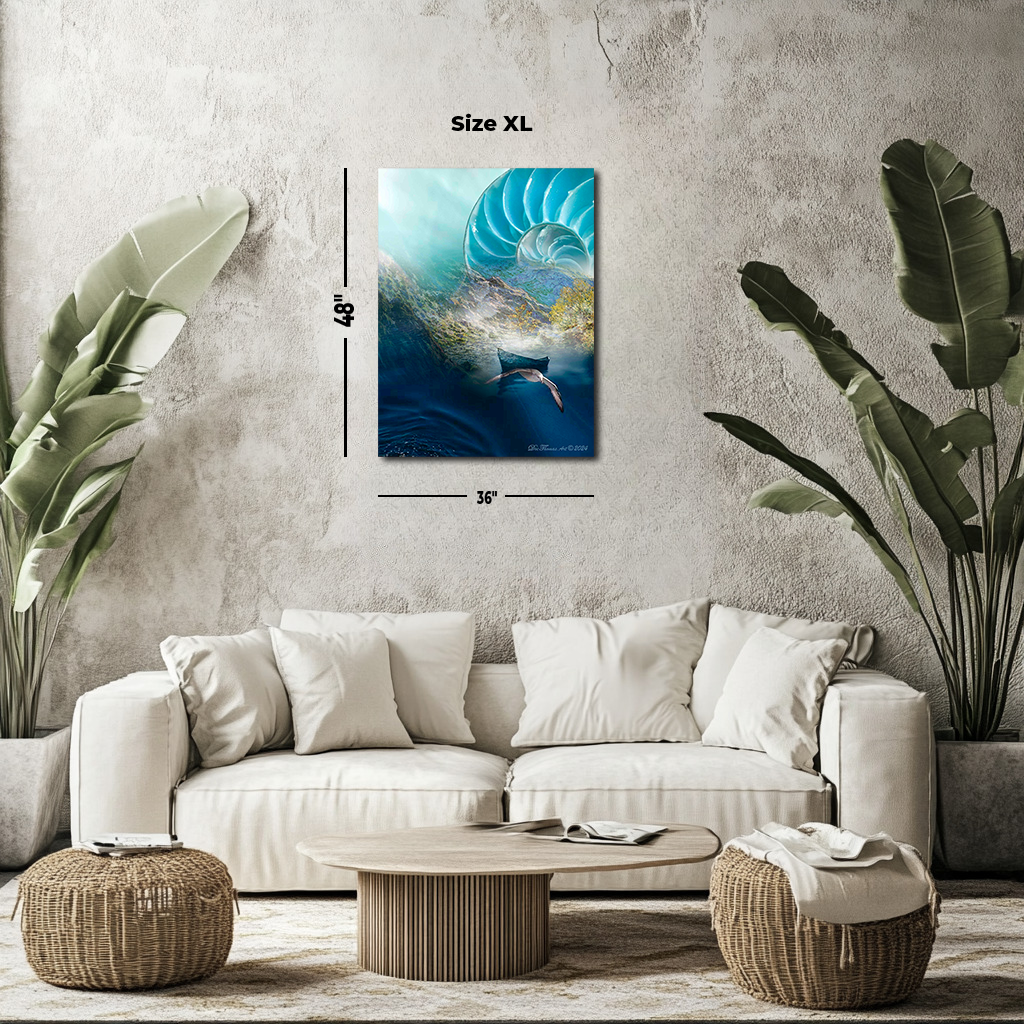Journey of the Soul: Nautilus Echoes Above the Petite Creuse
This conceptual reinterpretation of Claude Monet’s The Petite Creuse River (1889) merges tranquil natural elements with surreal symbolism to express the fluidity of perception and the timeless human quest for meaning. A luminous, translucent spiral shell dominates the composition, resonating with Monet’s gentle waterscape. A solitary boat and soaring gull symbolize individual journeys through life's currents and aspirations toward transcendence. This piece beautifully embodies the tension between ephemeral experience and eternal rhythms, encouraging reflective contemplation of nature, consciousness, and inner serenity.
Please see Below for Details…
Hotline Order:
Mon - Fri: 07AM - 06PM
404-872-4663
Claude Monet’s The Petite Creuse River (1889) captures far more than a mere depiction of tranquil waters and lush riverbanks—it embodies a meditation on nature’s delicate yet enduring harmony, the subtle poetry of movement, and the quiet resonance of solitude. Monet, ever enchanted by the reflective and rhythmic character of water, painted this scene with a sensitivity to both its fluid form and its deeper, elusive essence. His original vision transforms a river into a contemplative mirror, where sky and land merge gently, blurring boundaries between tangible reality and emotional perception, between the observable world and our internal landscapes.
This conceptual reinterpretation expands Monet’s intimate dialogue with water into a surreal exploration of harmony and natural rhythm, a layered contemplation that transcends literal depiction into something deeply symbolic. Here, Monet’s gentle, verdant banks and softly rippling waters become intertwined with elements that speak to the mysteries of nature, consciousness, and time. The composition's focal point—a large, spiral shell, luminous with translucent blues and serene greens—dominates the scene, its geometry perfect and hypnotic, echoing the golden ratio, nature’s silent poetry of infinite growth and unfolding potential.
This shell serves not merely as a decorative addition but as a profound metaphor. It symbolizes the continuity of life, the endless cycles of growth and transformation, and the inherent patterns hidden within nature. Its graceful spiral curves resonate visually and metaphorically with Monet’s riverscape, reinforcing the sense of continuity between the natural world and human perception. The shell, translucent and radiant, gently hovers over the landscape, appearing simultaneously timeless and transient, a tangible reminder of nature’s ceaselessly repeating patterns, visible yet eternally elusive.
Below this symbol of eternity and nature’s geometry, a lone boat drifts quietly upon the river. The boat is empty, embodying a sense of absence, contemplation, and potential journey. It floats softly, held by gentle waters that echo Monet’s original brushwork—flowing, rhythmic, and dreamlike. The boat, empty and inviting contemplation, symbolizes the individual’s solitary journey through life’s currents. The subtle motion of the boat, gently swayed by hidden currents, mirrors humanity’s subtle movement through experiences, relationships, and memories, reinforcing Monet’s belief in water as a powerful metaphor for life’s fluidity.
Emerging from the composition’s lower foreground, a graceful bird soars just above the reflective surface of the water. Its wings catch the diffused light streaming through the misty air, casting a soft glow over its form, embodying freedom, transcendence, and the aspirational spirit. The bird's flight is peaceful yet purposeful, its wings spread wide in harmonious balance, symbolizing the human spirit’s eternal desire to rise above earthly constraints, to seek clarity and serenity amid life’s uncertainties.
The surrounding landscape blends seamlessly into the abstract and surreal elements of the composition. Monet’s original greens and soft blues dissolve into misty atmospheres, suggesting a landscape suspended between reality and imagination. The gentle blending of colors and forms, intentional and dreamlike, evokes a sense of memory, the indistinct boundaries between the tangible and intangible worlds, and highlights Monet’s deep interest in the changing effects of light and weather. The subtle interplay between solidity and mist creates a visual tension—what appears certain and clear at first glance gently reveals layers of ambiguity and mystery, emphasizing the fragile yet powerful nature of perception.
At the forefront, water ripples softly, painted in hues of deep blues and gentle turquoise, their movements gentle but persistent. This calm yet dynamic surface is a metaphor for human consciousness—ever-changing, reflecting experiences and emotions yet never fully revealing the depths beneath. Above, distant cliffs and foliage blend and blur gently into radiant, dreamlike tones, their colors soft and inviting, hinting at Monet’s own fascination with capturing fleeting atmospheric moments, translating the landscape into a luminous narrative of sensation and emotion rather than mere visual representation.
Through this conceptual reinterpretation, my intention was to evoke a sense of introspection, inviting the viewer into a deeper contemplation of life’s mysteries, of the interconnectedness between human experience and the natural world. Monet’s original painting, dated from the artist’s continuous exploration during 1889, sought to capture the ephemeral beauty found within everyday surroundings. Here, I expanded upon that exploration, suggesting that nature’s patterns echo within the rhythms of human life itself, inviting reflection on our journey, our dreams, our memories, and our aspirations.
The spiral shell symbolizes nature’s harmony and eternal cycles, while the empty boat symbolizes the human quest for meaning within that eternal flow. The gull gliding gracefully across the foreground reinforces the sense of freedom and transcendence, reminding us of our capacity to rise, to soar above the ordinary, to seek deeper meaning within the quiet rhythms of existence.
This piece encourages us to pause, reflect, and recognize the gentle beauty that surrounds us. It is a poetic celebration of Monet’s quiet insight into nature, enriched and expanded into a timeless meditation on existence, perception, and the perpetual pursuit of harmony within the delicate balance of our internal and external worlds.
Add your review
Your email address will not be published. Required fields are marked *
Please login to write review!
Looks like there are no reviews yet.








